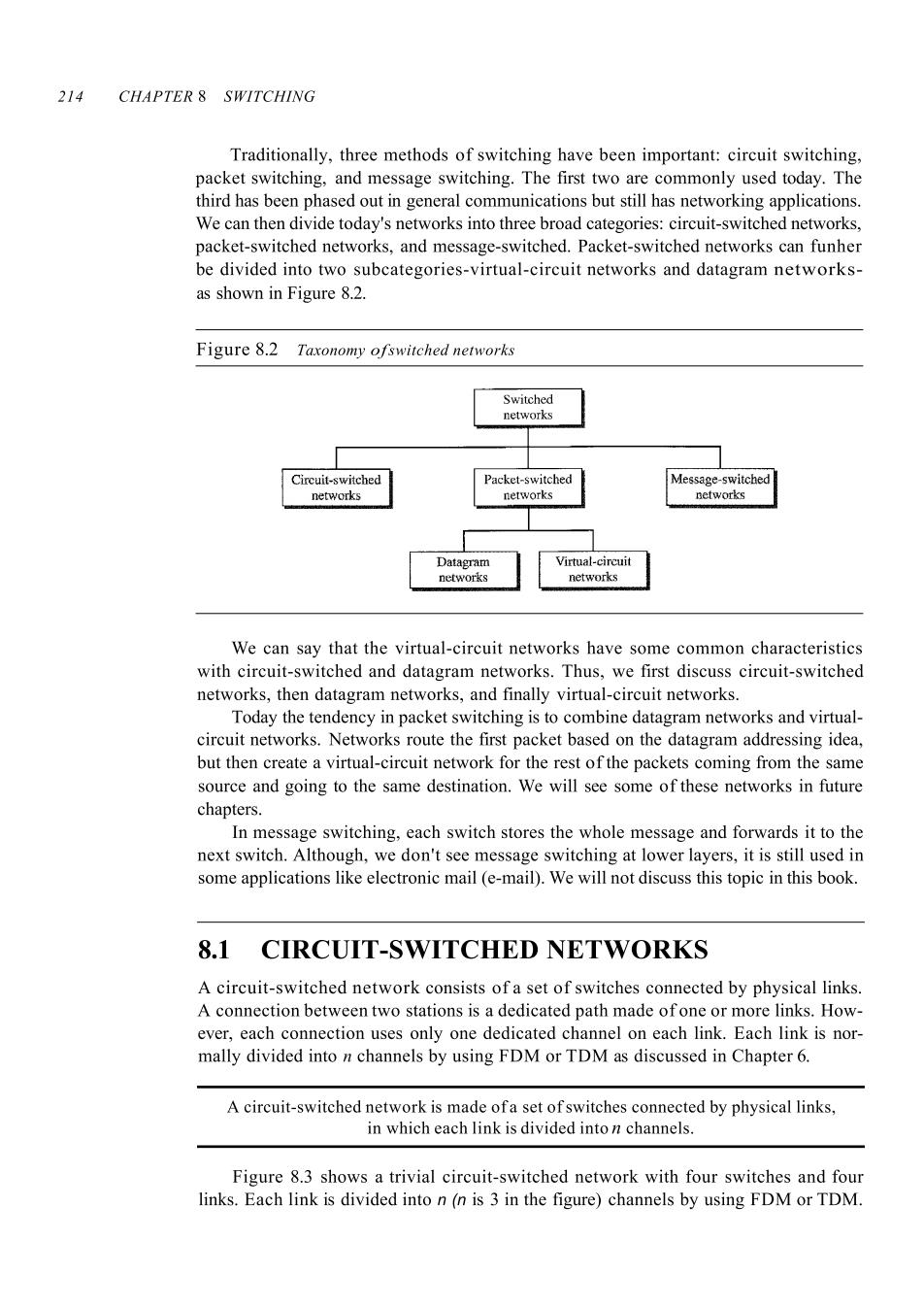正在加载图片...

214 CHAPTER 8 SWITCHING Traditionally,three methods of switching have been important:circuit switching, packet switching,and message switching.The first two are commonly used today.The third has been phased out in general communications but still has networking applications. We can then divide today's networks into three broad categories:circuit-switched networks, packet-switched networks,and message-switched.Packet-switched networks can funher be divided into two subcategories-virtual-circuit networks and datagram networks- as shown in Figure 8.2. Figure 8.2 Taxonomy ofswitched networks Switched networks Circuit-switched Packet-switched Message-switched networks networks networks Datagram Virtual-circuit networks networks We can say that the virtual-circuit networks have some common characteristics with circuit-switched and datagram networks.Thus,we first discuss circuit-switched networks,then datagram networks,and finally virtual-circuit networks. Today the tendency in packet switching is to combine datagram networks and virtual- circuit networks.Networks route the first packet based on the datagram addressing idea, but then create a virtual-circuit network for the rest of the packets coming from the same source and going to the same destination.We will see some of these networks in future chapters. In message switching,each switch stores the whole message and forwards it to the next switch.Although,we don't see message switching at lower layers,it is still used in some applications like electronic mail (e-mail).We will not discuss this topic in this book. 8.1 CIRCUIT-SWITCHED NETWORKS A circuit-switched network consists of a set of switches connected by physical links. A connection between two stations is a dedicated path made ofone or more links.How- ever,each connection uses only one dedicated channel on each link.Each link is nor- mally divided into n channels by using FDM or TDM as discussed in Chapter 6. A circuit-switched network is made ofa set of switches connected by physical links, in which each link is divided into n channels. Figure 8.3 shows a trivial circuit-switched network with four switches and four links.Each link is divided into n(n is 3 in the figure)channels by using FDM or TDM.
!"
#
$
%
&'""( !"
# &")
!"
#
#
!"
#*
!
"
(
*
%
&
(#
"
(" %(
!)#&&" * +
"
$
,
!)
%"
#
'""(- !"
!) &")
- !"
!)
#
- !"
*.")
- !"
!) " (
%
$
! (%"
#
-$(-""(
!) #
!) -
!/#(
*0* /#(
*0 12343563789:;<=>?4>;93@A8 +
"
$(-""(
!)
$
"
"
"
" !
""(- !"
#
!) *
( !
"( ""(- !"
!)
#
!) $(-""(
!) *
"&")
!"
# "
%
#
!) $(- ""(
!) *B
!) (
&")
%
#
#
%(
"
$(-""(
!)
&")
"
#
("
##
*+
!
!) ((
"
&
* C
#
!"
#
"
!"
!
#
!
D !"
*E
(#
!
,
#
!"
#!
(
&&" )
""
F
-
G*+
! "(
&"
%)* HIJ KLMKNLOPQRLOKSTUVTORWMXQ E""(- !"
!)"
!"
"
"
%&
") * E"
"%
!
!
"
&
) *Y!-
$
"
"
"(
"
"
"
)*Z"
) -
$
4"
%( #/[\ [\ "(
]
&
^* E""(- !"
!)
!"
"
"
%&
") !
"
"
) $
4"
* /#(
*_
! $""(- !"
!)!
( !"
( ) *Z"
) $
`a` _
#(
G"
%( #/[\ [\*��